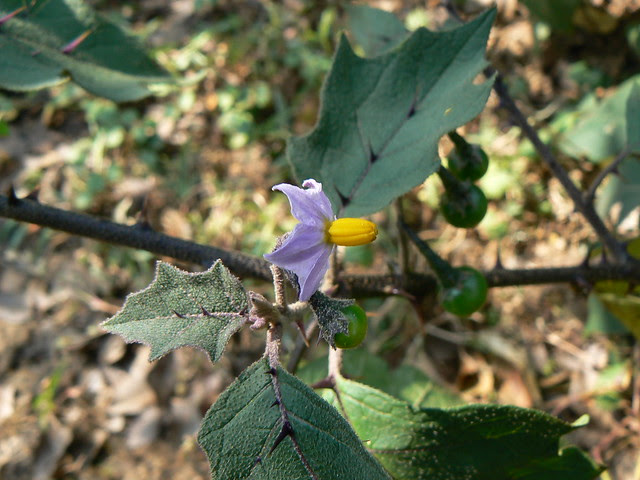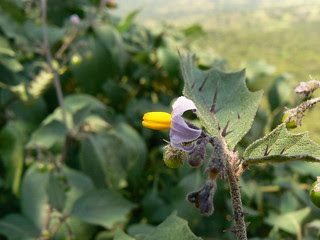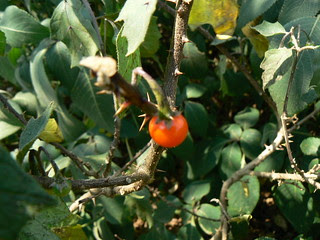Kas Week :: DV :: 19 OCT 07 - 1120 :: Solanum lasiocarpum
Dinesh Valke

|
|
Kas plateau
...
about 4000 ft asl ... one of the 39 World Heritage sites in the Western Ghats of India |
|
19 OCT 07 Solanum lasiocarpum Dunal ... (family: Solanaceae)
so-LAN-num -- solace, quietude; referring to narcotic properties of some species ... Dave's Botanary
las-ee-oh-KAR-pum -- woolly fruit ... Dave's Botanary commonly known as: Indian nightshade, poison berry, wild Indian brinjal • Assamese: তিতা-ভেকুৰি tita-bhekuri • Gujarati: ઊભી ભોંય રિંગણી ubhi bhoy ringani • Hindi: बरहट्टा barhatta, कोलसा kolsa • Kannada: ಕಿರಿಯ ಗುಳ kiriya gula • Manipuri: leipungkhangga • Marathi: चिंचुरडी chinchurdi, लालकांगोणी lalkangoni • Mizo: maihrem, samtawkte • Nepalese: बिहिँ bihi • Oriya: tutuguno • Sanskrit: बृहती brihati, क्षुद्रभण्टाकी kshudrabhantaaki, प्रचोदिनी prachodini, स्वादुपाका svadupaka, वार्ताकी vaartaaki • Tamil: சிறுவழுதுணை ciru-valutunai, கரிமுள்ளி kari-mulli, நாய்முள்ளி nay-mulli • Telugu: తెల్లములక tellamulaka, వార్తాకి vartaki • Tibetan: bri ha ti Native to: s China, Indian subcontinent, Indo-China, Malesia; cultivated in tropical Asia References: Flowers of India • NPGS / GRIN • ENVIS - FRLHT • DDSA |



|
|
Regards. Dinesh |
Prabhu kumar KM
Prabhu Kumar K M
Scientist
Centre for Medicinal Plants Research (CMPR)
Kottakkal, Malappuram
Dinesh Valke
I will do the changes in my flickr notes shortly.
Regards.
Dinesh
Gurcharan Singh
SGTB Khalsa College, University of Delhi, Delhi-110007
Res: 932 Anand Kunj, Vikas Puri, New Delhi-110018.
Phone: 011-25518297 Mob: 9810359089
--
Satish Phadke
Dr Satish Phadke
--
Gurcharan Singh
SGTB Khalsa College, University of Delhi, Delhi-110007
Res: 932 Anand Kunj, Vikas Puri, New Delhi-110018.
Phone: 011-25518297 Mob: 9810359089
Dinesh Valke
doi:10.36808/if/1975/v101i10/27060.
J.M. Garg
Pl. check with this also and confirm.
Deb (1979) relegated S. hovei to the synonymy of the widespread and highly variable Solanum violaceum (as S. indicum). Solanum violaceum differs from S. hovei in having recurved cauline prickles, broadly elliptic to ovate leaves, sinuate to more deeply lobed leaf margins, rounded to subcordate leaf bases, and erect fruiting pedicels. In contrast, S. hovei has predominantly straight cauline prickles, rhombic to subelliptic leaves, shallowly triangular-lobed leaf margins, acute to short-attenuate leaf bases, and often recurved fruiting pedicels.
--
You received this message because you are subscribed to the Google Groups "eFloraofIndia" group.
To unsubscribe from this group and stop receiving emails from it, send an email to indiantreepi...@googlegroups.com.
To view this discussion on the web, visit https://groups.google.com/d/msgid/indiantreepix/06eb2763-8e57-417e-8126-bc80ae1ca278n%40googlegroups.com.
J.M.Garg
J.M. Garg
J.M.Garg
Dinesh Valke
--
You received this message because you are subscribed to a topic in the Google Groups "eFloraofIndia" group.
To unsubscribe from this topic, visit https://groups.google.com/d/topic/indiantreepix/z1Uo4-SDrNU/unsubscribe.
To unsubscribe from this group and all its topics, send an email to indiantreepi...@googlegroups.com.
J.M. Garg
With regards,
J. M. Garg
You received this message because you are subscribed to the Google Groups "eFloraofIndia" group.
To unsubscribe from this group and stop receiving emails from it, send an email to indiantreepi...@googlegroups.com.
To view this discussion on the web, visit https://groups.google.com/d/msgid/indiantreepix/CABSQqC2kofoEOYKKo%3DSj36C%2B6tQc1QpW-Z8%3DCE-9BPUhub9FaQ%40mail.gmail.com.
Dinesh Valke
Dinesh Valke
"Solanum hovei is a member of a group of species identified in the molecular analyses of Aubriot et al. (2016a) as the ‘S. violaceum group’. It is morphologically similar to the sympatric and widespread S. violaceum but differs from it in having leaves with more sparsely pubescent adaxial surfaces and cuneate (rather than acute or truncate) bases. The pedicels of S. hovei are strongly deflexed in fruit, while those of S. violaceum are spreading. Solanum multiflorum of western India also has strongly deflexed pedicels, but they are shorter, and the leaves are densely pubescent with longer trichomes.
Sen Gupta (1964) suggested S. hovei was a rare plant in the Western Ghats, but the number of recent collections in local herbaria suggest otherwise. It is probable that S. hovei was largely confused with S. violaceum in herbaria (usually identified as S. indicum)."
The leaf shape, type of stem prickles and deflexed fruiting pedicels of this plant indicate S. hovei in my opinion.
There's also this under the section for S. violaceum:
"Solanum violaceum is sympatric with its close relatives S.
deflexicarpum of southern China, S. hovei, and S. multiflorum, the
latter two endemic to India. All of these species have strongly deflexed
pedicels in fruit, while those of S. violaceum are broadly spreading
and usually longer."
S. violaceum for comparison, with differently shaped leaf bases and spreading fruiting pedicels. Its stems are either unarmed or armed with (usually) curved prickles.
And as discussed in your link, S. lasiocarpum is a different plant with broader leaves, white flowers, and pubescent fruits
J.M. Garg
J.M.Garg
